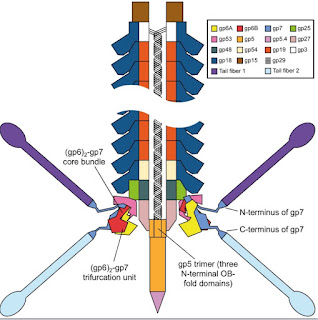Peptidoglycan is the main component of the bacterial wall and protects cells from the mechanical stress that results from high intracellular turgor. Peptidoglycan biosynthesis is very similar in all bacteria; bacterial shapes are therefore mainly determined by the spatial and temporal regulation of peptidoglycan synthesis rather than by the chemical composition of peptidoglycan. The form of rod-shaped bacteria, such as Bacillus subtilis or Escherichia coli, is generated by the action of two peptidoglycan synthesis machineries that act at the septum and at the lateral wall in processes coordinated by the cytoskeletal proteins FtsZ and MreB, respectively1,2. The tubulin homologue FtsZ is the first protein recruited to the division site, where it assembles in filaments—forming the Z ring—that undergo treadmilling and recruit later divisome proteins3,4. The rate of treadmilling in B. subtilis controls the rates of both peptidoglycan synthesis and cell division3. The actin homologue MreB forms discrete patches that move circumferentially around the cell in tracks perpendicular to the long axis of the cell, and organize the insertion of new cell wall during elongation5,6. Cocci such as Staphylococcus aureus possess only one type of peptidoglycan synthesis machinery7,8, which is diverted from the cell periphery to the septum in preparation for division9. The molecular cue that coordinates this transition has remained elusive. Here we investigate the localization of S. aureus peptidoglycan biosynthesis proteins and show that the recruitment of the putative lipid II flippase MurJ to the septum, by the DivIB–DivIC–FtsL complex, drives peptidoglycan incorporation to the midcell. MurJ recruitment corresponds to a turning point in cytokinesis, which is slow and dependent on FtsZ treadmilling before MurJ arrival but becomes faster and independent of FtsZ treadmilling after peptidoglycan synthesis activity is directed to the septum, where it provides additional force for cell envelope constriction.
a, Schematic of the peptidoglycan synthesis pathway in S. aureus. UDP, uridine diphosphate. b, Structured illumination microscopy (SIM) images of S. aureus cells expressing fluorescent derivatives of PG synthesis proteins. Scale bars, 0.5 μm. Images are representative of three biological replicates. c, Ratios between fluorescence signal at the septum and the peripheral membrane, measured in cells with a complete septum (phase 3). Blue, membrane proteins with fluorescence ratio of approximately 2, similar to Nile Red staining of COL membrane (expected as the septum contains two membranes versus one in the cell periphery). Green, septal enriched proteins with 2.5 < fluorescence ratio < 3.5. Red, septal proteins with fluorescence ratio > 4. Data are represented as column graphs in which the height of the column is the mean and whiskers are s.d. From left to right, n = 439, 533, 516, 513, 512, 622, 503, 517, 503, 689, 1,321, 488 and 516 cells. AU, arbitrary unit. d, Schematic of the S. aureuscell cycle. Phase 1 cells have not initiated septum synthesis, phase 2 cells are undergoing septum synthesis and phase 3 cells have a complete septum undergoing maturation in preparation for splitting.



